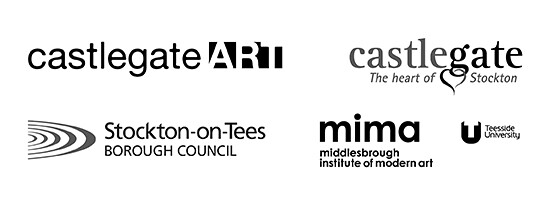July 26, 2017–June 30, 2019
Middlesbrough Institute of Modern Art, part of Teesside University, is moving forward with a vision of itself as a “useful museum,” or “museum 3.0,” under the directorship of Alistair Hudson and with programming by Miguel Amado and Elinor Morgan. It is an institution with a social function that repurposes art as a tool, pursuing a civic agenda and contributing to change. It focuses on public engagement, establishing the gallery as a site based on use value and fostering community building, with the actions of its users and constituent groups defining its meaning.
Castlegate Art
Castlegate Art is an initiative of Castlegate Shopping Centre, supported by Stockton-on-Tees Borough Council and organized by Middlesbrough Institute of Modern Art. Every two years, an artist is invited to make a work for display on the rear exterior of the Castlegate Shopping Centre in central Stockton-on-Tees, which faces out onto the River Tees. The Greek Armenian artist Aikaterini Gegisian (b. 1976) has been commissioned for the 2017 edition of Castlegate Art, and has created Turn Back Tide.
Turn Back Tide
Aikaterini Gegisian examines questions of displacement, diasporic identities, belonging, and collective memory. Her practice spans film, photography, and installation; in her words, it considers “how images, operating in a media environment that shapes the conscious and the unconscious, contain new possibilities for thought.” In her photographic output, she juxtaposes found photographs from a variety of contexts to establish connections between disparate visualities, eras, peoples, and histories.
Turn Back Tide is part of a series of works in which Gegisian explores the economic heritage of the northeast of England, specifically the Tees Valley, in the context of the manufacturing and consumption of images and goods. The intent is to make connections between the ruins of past civilizations and the decline of the industrial structures that have historically characterized this region.
The work takes as its starting point archival material—particularly a series of product catalogues—from various former local steel plants, including South Durham Steel and Iron Co. and Head Wrightson. Gegisian put into dialogue diagrams of steel sections from these publications with photographs of old local factories, views of 1980s shopping centers reproduced in a book, depictions of ancient temples taken from archaeology treatises, and magazine cuttings of decorative objects.
Turn Back Tide acts as a bridge between the former sites of production surrounding Stockton-on-Tees, the River Tees as a traditional route for the transportation of goods and natural resources, and the shopping center as today’s container of goods. It suggests a fluid evolution from the area’s industrial past toward its current status as a hub of trade and service provision.
Aikaterini Gegisian lives and works between Middlesbrough, England, and Thessaloniki, Greece. In 2015 she was one of the artists participating in the Armenian Pavilion at the 56th Venice Biennale, which received the Golden Lion for best national participation. Her work was been featured in exhibitions such as the 6th Moscow Biennale; 3rd Mardin Biennale (Turkey); 2nd Tallin Photomonth (Estonia); 1st Thessaloniki Biennale; and 6th Gyumri Biennale (Armenia). Her work has also been shown at DEPO, Istanbul; BALTIC, Newcastle; Calvert 22 Foundation, London; Stavros Niarchos Foundation Cultural Center, Athens; NARS Foundation, New York; Thessaloniki Centre of Contemporary Art; and Spike Island, Bristol, England.


